Classification of Latin American and Caribbean Countries Based on Multidimensional Development Indicators: A Multivariate Empirical Analysis
Abstract
1. Introduction
2. Literature Review
2.1. Principal Component Analysis (PCA)
2.2. Cluster Analysis
2.3. Integration of PCA and Cluster Analysis
2.4. Recent Overview of Multidimensional Development in Latin America
3. Methodology
Study Population
- Kaiser’s Criterion: Components with eigenvalues greater than 1 are retained.
- Explained Variance: Components that explain at least 70% of the total variability are selected.
- Scree Plot: Identification of the inflection point on the eigenvalue curve.
- Sample Adequacy: Bartlett’s test of sphericity.
- PCA Robustness: Comparison of results with alternative normalizations of the variables.
- Clustering Stability: Assessment by repeating the analysis with different distance metrics.
4. Results
4.1. Results of Principal Component Analysis
4.2. Cluster Analysis Results
- Low access to internet and mobile devices;
- Low Global Innovation Index (GII);
- Low percentage of investment in health and education.
- High percentage of investment in health;
- Low GDP and energy consumption per capita;
- Medium internet access.
- A percentage of investment in health that is slightly lower than the world average.
- Significantly higher levels of GDP per capita, Global Innovation Index (GII), internet access, energy consumption per capita, and access to mobile devices.
- Significantly higher levels of CO2 emissions and energy consumption per capita.
5. Discussion
Interpretación Integral de Los Conglomerados: Desempeño, Estructura y Fundamentos Teóricos
6. Conclusions
Author Contributions
Funding
Institutional Review Board Statement
Informed Consent Statement
Data Availability Statement
Conflicts of Interest
References
- Abson, D. J., Dougill, A. J., & Stringer, L. C. (2012). Using principal component analysis for information-rich socio-ecological vulnerability mapping in Southern Africa. Applied Geography, 35(1–2), 515–524. [Google Scholar] [CrossRef]
- Ahlborn, M., & Schweickert, R. (2019). Economic systems in developing countries—A macro cluster approach. Economic Systems, 43(3–4), 100692. [Google Scholar] [CrossRef]
- Ahmed, Z., Nathaniel, S. P., & Shahbaz, M. (2021). The criticality of information and communication technology and human capital in environmental sustainability: Evidence from Latin American and Caribbean countries. Journal of Cleaner Production, 286, 125529. [Google Scholar] [CrossRef]
- Alkhayrat, M., Aljnidi, M., & Aljoumaa, K. (2020). A comparative dimensionality reduction study in telecom customer segmentation using deep learning and PCA. Journal of Big Data, 7(1), 9. [Google Scholar] [CrossRef]
- Almulhim, T. (2024). Assessment of green development level performance in G20 countries: A dynamic evaluation framework. Heliyon, 10(18), e37622. [Google Scholar] [CrossRef]
- Al-Worafi, Y. M. (2024). Technology in public health education in developing countries. In Handbook of medical and health sciences in developing countries: Education, practice, and research (pp. 1–20). Springer International Publishing. [Google Scholar]
- Amarante, V., & Colacce, M. (2022). Multidimensional poverty among older people in five Latin American countries. Social Indicators Research, 159(3), 945–965. [Google Scholar] [CrossRef]
- Asongu, S. A., & Nwachukwu, J. C. (2017). The comparative inclusive human development of globalization in Africa. Social Indicators Research, 134, 1027–1050. [Google Scholar] [CrossRef]
- Barska, A., Jędrzejczak-Gas, J., Wyrwa, J., & Kononowicz, K. (2020). Multidimensional assessment of the social development of EU countries in the context of implementing the concept of sustainable development. Sustainability, 12(18), 7821. [Google Scholar] [CrossRef]
- Bravo-Sanzana, M. V., Varela, J., Terán-Mendoza, O., & Rodriguez-Rivas, M. E. (2023). Measuring school social climate in Latin America: The need for multidimensional and multi-informant tests—A systematic review. Frontiers in Psychology, 14, 1190432. [Google Scholar] [CrossRef] [PubMed]
- Cooper, W. W., Seiford, L. M., & Tone, K. (2007). Data envelopment analysis: Comprehensive text with models, applications, references and DEA-solver software (Vol. 2, p. 489). Springer. [Google Scholar]
- Cruz-Martínez, G. (2014). Welfare state development in Latin America and the Caribbean (1970s–2000s): Multidimensional welfare index, its methodology and results. Social Indicators Research, 119, 1295–1317. [Google Scholar] [CrossRef]
- Dai, P. F., Xiong, X., & Zhou, W. X. (2021). A global economic policy uncertainty index from principal component analysis. Finance Research Letters, 40, 101686. [Google Scholar] [CrossRef]
- Ester, M., Kriegel, H. P., Sander, J., & Xu, X. (1996, August 2–4). A density-based algorithm for discovering clusters in large spatial databases with noise. Kdd (Vol. 96, No. 34, pp. 226–231), Portland, OR, USA. [Google Scholar]
- Gewers, F. L., Ferreira, G. R., Arruda, H. F. D., Silva, F. N., Comin, C. H., Amancio, D. R., & Costa, L. D. F. (2021). Principal component analysis: A natural approach to data exploration. ACM Computing Surveys (CSUR), 54(4), 1–34. [Google Scholar]
- González, P., Sehnbruch, K., Apablaza, M., Méndez Pineda, R., & Arriagada, V. (2021). A multidimensional approach to measuring quality of employment (QoE) deprivation in six central American countries. Social Indicators Research, 158(1), 107–141. [Google Scholar] [CrossRef]
- Guillén-Fernández, Y. B. (2024). Socioeconomic factors determining multidimensional child poverty groups in central America: A measurement proposal from the wellbeing approach using a comprehensive set of children’s rights. Child Indicators Research, 17(5), 2175–2217. [Google Scholar] [CrossRef]
- Guo, H., Liang, D., Sun, Z., Chen, F., Wang, X., Li, J., Zhu, L., Bian, J., Wei, Y., Huang, L., Chen, Y., Peng, D., Li, X., Lu, S., Liu, J., & Shirazi, Z. (2022). Measuring and evaluating SDG indicators with Big Earth Data. Science Bulletin, 67(17), 1792–1801. [Google Scholar] [CrossRef] [PubMed]
- Haining, K., Gajwani, R., Gross, J., Gumley, A. I., Ince, R. A. A., Lawrie, S. M., Schultze-Lutter, F., Schwannauer, M., & Uhlhaas, P. J. (2022). Characterizing cognitive heterogeneity in individuals at clinical high-risk for psychosis: A cluster analysis with clinical and functional outcome prediction. European Archives of Psychiatry and Clinical Neuroscience, 272(3), 437–448. [Google Scholar] [CrossRef]
- Husson, F., Josse, J., Lê, S. F., & FactoMineR, J. M. (2023). Multivariate exploratory data analysis and data mining with R Package ‘FactoMineR’. Available online: https://cran.r-project.org/web/packages/FactoMineR/index.html (accessed on 27 May 2025).
- Husson, F., Josse, J., & Pages, J. (2010). Principal component methods-hierarchical clustering-partitional clustering: Why would we need to choose for visualizing data. Applied Mathematics Department, 2010, 1–17. [Google Scholar]
- Jansson, N. F., Allen, R. L., Skogsmo, G., & Tavakoli, S. (2022). Principal component analysis and K-means clustering as tools during exploration for Zn skarn deposits and industrial carbonates, Sala area, Sweden. Journal of Geochemical Exploration, 233, 106909. [Google Scholar] [CrossRef]
- Jiang, Q., Liu, Z., Liu, W., Li, T., Cong, W., Zhang, H., & Shi, J. (2018). A principal component analysis based three-dimensional sustainability assessment model to evaluate corporate sustainable performance. Journal of Cleaner Production, 187, 625–637. [Google Scholar] [CrossRef]
- Jiménez-Preciado, A. L., Cruz-Aké, S., & Venegas-Martínez, F. (2024). Identification of patterns in CO2 emissions among 208 countries: K-Means clustering combined with PCA and non-linear t-SNE visualization. Mathematics, 12(16), 2591. [Google Scholar] [CrossRef]
- Jolliffe, I. T. (2002). Principal component analysis for special types of data (pp. 338–372). Springer. [Google Scholar]
- Jolliffe, I. T., & Cadima, J. (2016). Principal component analysis: A review and recent developments. Philosophical Transactions of the Royal Society A: Mathematical, Physical and Engineering Sciences, 374(2065), 20150202. [Google Scholar] [CrossRef]
- Kamari, A., & Schultz, C. P. L. (2022). A combined principal component analysis and clustering approach for exploring enormous renovation design spaces. Journal of Building Engineering, 48, 103971. [Google Scholar] [CrossRef]
- Kassambara, A., & Mundt, F. (2016). Package “factoextra”. Extract and visualize the results of multivariate data analyses. Available online: https://cran.r-project.org/web/packages/factoextra/index.html (accessed on 27 May 2025).
- Kaufman, L., & Rousseeuw, P. J. (2009). Finding groups in data: An introduction to cluster analysis. John Wiley & Sons. [Google Scholar]
- Korir, E. K. (2024). Comparative clustering and visualization of socioeconomic and health indicators: A case of Kenya. Socio-Economic Planning Sciences, 95, 101961. [Google Scholar] [CrossRef]
- Krishnan, S., & Firoz, M. (2023). Assessment of regional environmental quality using cluster analysis. Environmental Development, 45, 100832. [Google Scholar] [CrossRef]
- Krzyśko, M., Nijkamp, P., Ratajczak, W., & Wołyński, W. (2022). Multidimensional economic indicators and multivariate functional principal component analysis (MFPCA) in a comparative study of countries’ competitiveness. Journal of Geographical Systems, 24(1), 49–65. [Google Scholar] [CrossRef]
- Kurek, K. A., Heijman, W., van Ophem, J., Gędek, S., & Strojny, J. (2022). Measuring local competitiveness: Comparing and integrating two methods PCA and AHP. Quality & Quantity, 56(3), 1371–1389. [Google Scholar]
- MacQueen, J. (1967). Some methods for classification and analysis of multivariate observations. In Proceedings of the fifth Berkeley symposium on mathematical statistics and probability, volume 1: Statistics (Vol. 5, pp. 281–298). University of California Press. [Google Scholar]
- Medina-Hernández, E., Fernández-Gómez, M. J., & Barrera-Mellado, I. (2021). Gender inequality in Latin America: A multidimensional analysis based on ECLAC indicators. Sustainability, 13(23), 13140. [Google Scholar] [CrossRef]
- Möring-Martínez, G., Senzeybek, M., & Jochem, P. (2024). Clustering the European Union electric vehicle markets: A scenario analysis until 2035. Transportation Research Part D: Transport and Environment, 135, 104372. [Google Scholar] [CrossRef]
- Neri, L., D’Agostino, A., Regoli, A., Pulselli, F. M., & Coscieme, L. (2017). Evaluating dynamics of national economies through cluster analysis within the input-state-output sustainability framework. Ecological Indicators, 72, 77–90. [Google Scholar] [CrossRef]
- Niu, T., Huang, W., Zhang, C., Zeng, T., Chen, J., Li, Y., & Liu, Y. (2022). Study of degradation of fuel cell stack based on the collected high-dimensional data and clustering algorithms calculations. Energy and AI, 10, 100184. [Google Scholar] [CrossRef]
- Noman, A. A., Rehman, F. U., Khan, I., & Saeed, T. (2024). Trade competitiveness and sustainable energy practices: The moderating role of ecological footprint. Environmental and Sustainability Indicators, 21, 100331. [Google Scholar] [CrossRef]
- Pérez-Morote, R., Pontones-Rosa, C., & Núñez-Chicharro, M. (2020). The effects of e-government evaluation, trust and the digital divide in the levels of e-government use in European countries. Technological Forecasting and Social Change, 154, 119973. [Google Scholar] [CrossRef]
- Pick, J., Sarkar, A., & Parrish, E. (2021). The Latin American and Caribbean digital divide: A geospatial and multivariate analysis. Information Technology for Development, 27(2), 235–262. [Google Scholar] [CrossRef]
- Pinar, M. (2019). Multidimensional well-being and inequality across the European regions with alternative interactions between the well-being dimensions. Social Indicators Research, 144(1), 31–72. [Google Scholar] [CrossRef]
- Plaza-Díaz, J., Molina-Montes, E., Soto-Méndez, M. J., Madrigal, C., Hernández-Ruiz, Á., Valero, T., Villoslada, F. L., Leis, R., de Victoria, E. M., Moreno, J. M., Ortega, R. M., Ruiz-López, M. D., Varela-Moreiras, G., & Gil, Á. (2020). Clustering of dietary patterns and lifestyles among spanish children in the EsNuPi study. Nutrients, 12(9), 2536. [Google Scholar] [CrossRef]
- Pranata, K. S., Gunawan, A. A., & Gaol, F. L. (2023). Development clustering system IDX company with k-means algorithm and DBSCAN based on fundamental indicator and ESG. Procedia Computer Science, 216, 319–327. [Google Scholar] [CrossRef]
- Qazi, A. (2022). Adoption of a probabilistic network model investigating country risk drivers that influence logistics performance indicators. Environmental Impact Assessment Review, 94, 106760. [Google Scholar] [CrossRef]
- Ray, P., Reddy, S. S., & Banerjee, T. (2021). Various dimension reduction techniques for high dimensional data analysis: A review. Artificial Intelligence Review, 54(5), 3473–3515. [Google Scholar] [CrossRef]
- Romesburg, H. C. (2004). Cluster analysis for researchers. Lulu Press. [Google Scholar]
- Salem, N., & Hussein, S. (2019). Data dimensional reduction and principal components analysis. Procedia Computer Science, 163, 292–299. [Google Scholar] [CrossRef]
- Santiago, R., Fuinhas, J. A., & Marques, A. C. (2020). The impact of globalization and economic freedom on economic growth: The case of Latin America and Caribbean countries. Economic Change and Restructuring, 53(1), 61–85. [Google Scholar] [CrossRef]
- Santillán, O. S., Cedano, K. G., & Martínez, M. (2020). Analysis of energy poverty in 7 Latin American countries using multidimensional energy poverty index. Energies, 13(7), 1608. [Google Scholar] [CrossRef]
- Santos, G. F. D., Vives Vergara, A., Fuentes-Alburquenque, M., de Sousa Filho, J. F., Paiva, A. S., Useche, A. F., Yamada, G., Alfaro, T., Friche, A. A. L., Andrade, R. F. S., Barreto, M. L., Caiaffa, W. T., & Diez-Roux, A. V. (2023). Socioeconomic urban environment in Latin America: Towards a typology of cities. Sustainability, 15(8), 6380. [Google Scholar] [CrossRef]
- Spoor, J. M. (2023). Improving customer segmentation via classification of key accounts as outliers. Journal of Marketing Analytics, 11(4), 747–760. [Google Scholar] [CrossRef]
- Strielkowski, W., Chygryn, O., Drozd, S., & Koibichuk, V. (2024). Sustainable transformation of energy sector: Cluster analysis for the sustainable development strategies of selected European countries. Heliyon, 10(19), e38930. [Google Scholar] [CrossRef]
- Tripathi, S., Bachmann, N., Brunner, M., Tuezuen, A., Thienemann, A. K., Pöchtrager, S., & Jodlbauer, H. (2025). Evaluation of clustering with PCA for market segmentation: A study using simulated and surrogate data. Procedia Computer Science, 253, 2063–2075. [Google Scholar] [CrossRef]
- Van Leeuwen, R., & Koole, G. (2022). Data-driven market segmentation in hospitality using unsupervised machine learning. Machine Learning with Applications, 10, 100414. [Google Scholar] [CrossRef]
- Ward, J. H., Jr. (1963). Hierarchical grouping to optimize an objective function. Journal of the American Statistical Association, 58(301), 236–244. [Google Scholar] [CrossRef]
- Younes, K., Mouhtady, O., Chaouk, H., Obeid, E., Roufayel, R., Moghrabi, A., & Murshid, N. (2021). The application of principal component analysis (PCA) for the optimization of the conditions of fabrication of electropunk nanofibrous membrane for desalination and ion removal. Membranes, 11(12), 979. [Google Scholar] [CrossRef]
- Zhang, H., Cheng, S., Li, H., Fu, K., & Xu, Y. (2020). Groundwater pollution source identification and apportionment using PMF and PCA-APCA-MLR receptor models in a typical mixed land-use area in Southwestern China. Science of the Total Environment, 741, 140383. [Google Scholar] [CrossRef]
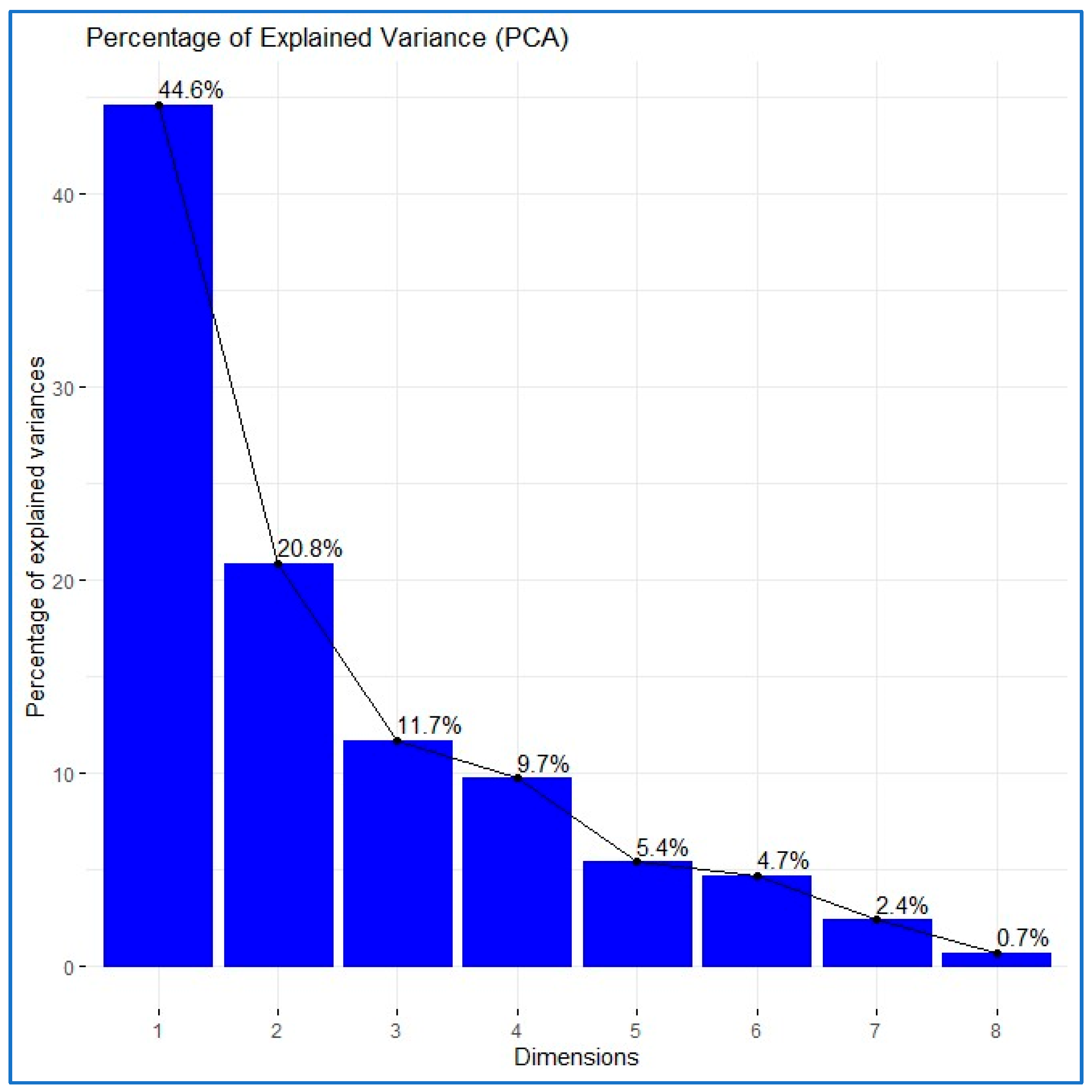
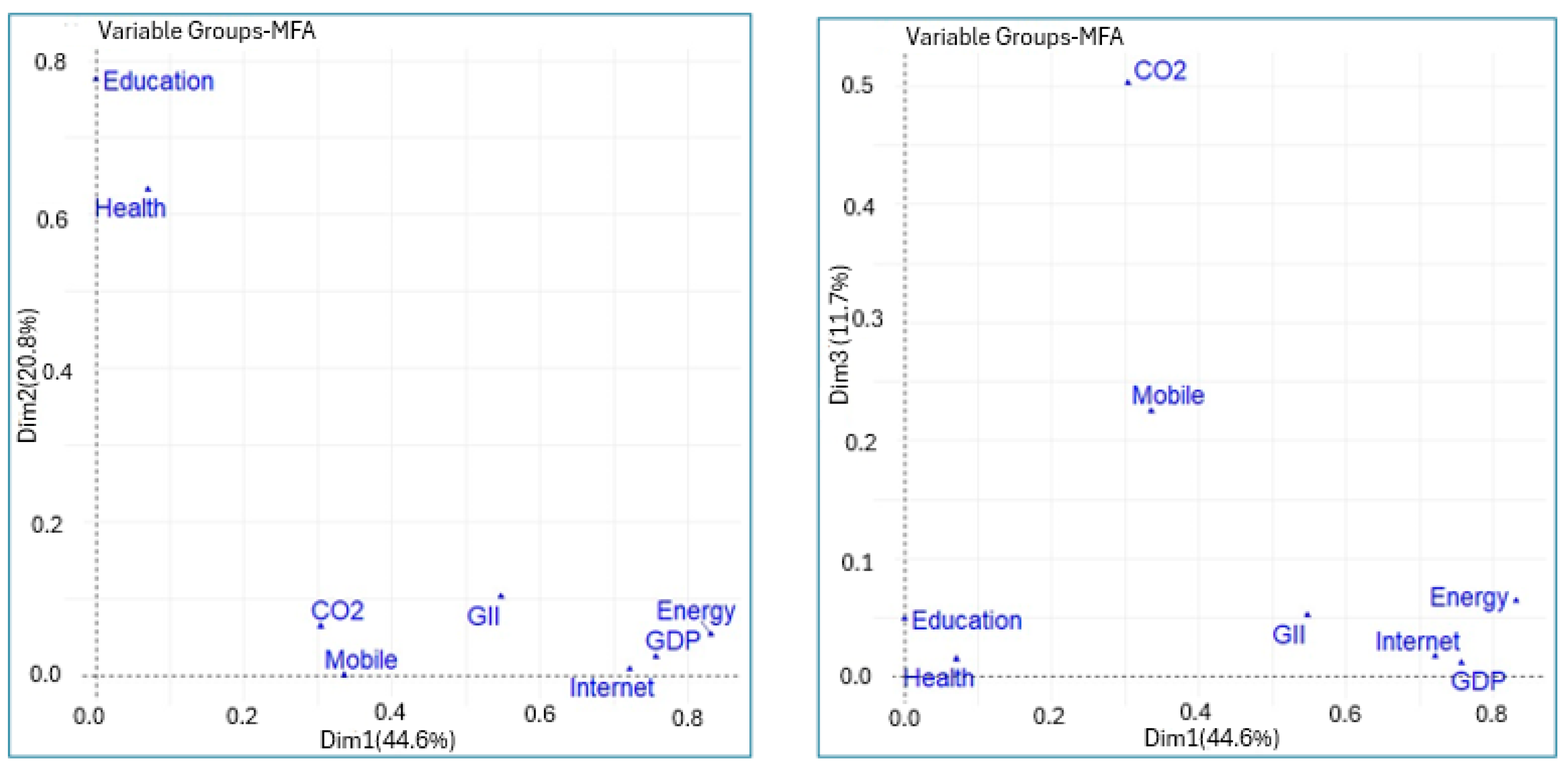
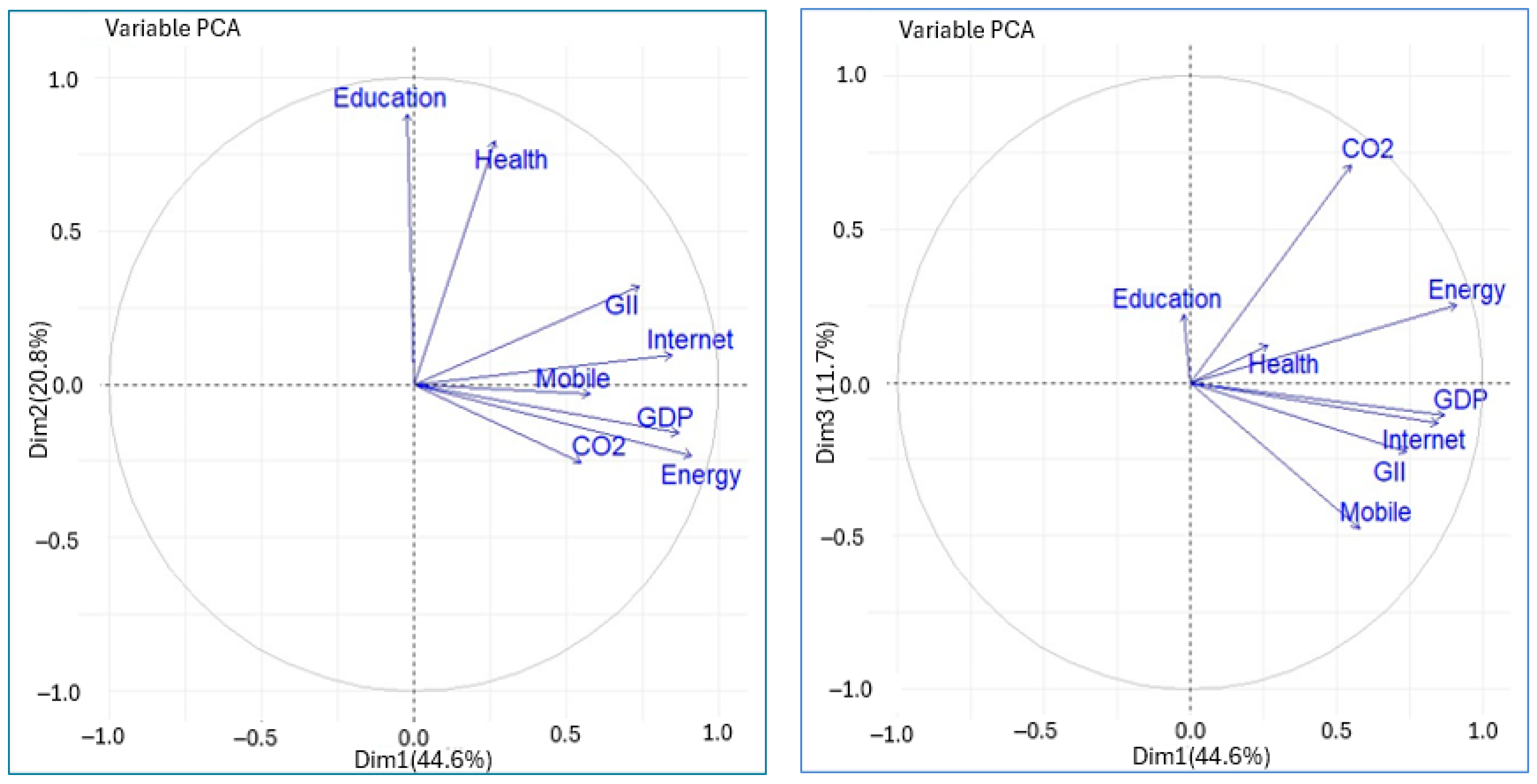
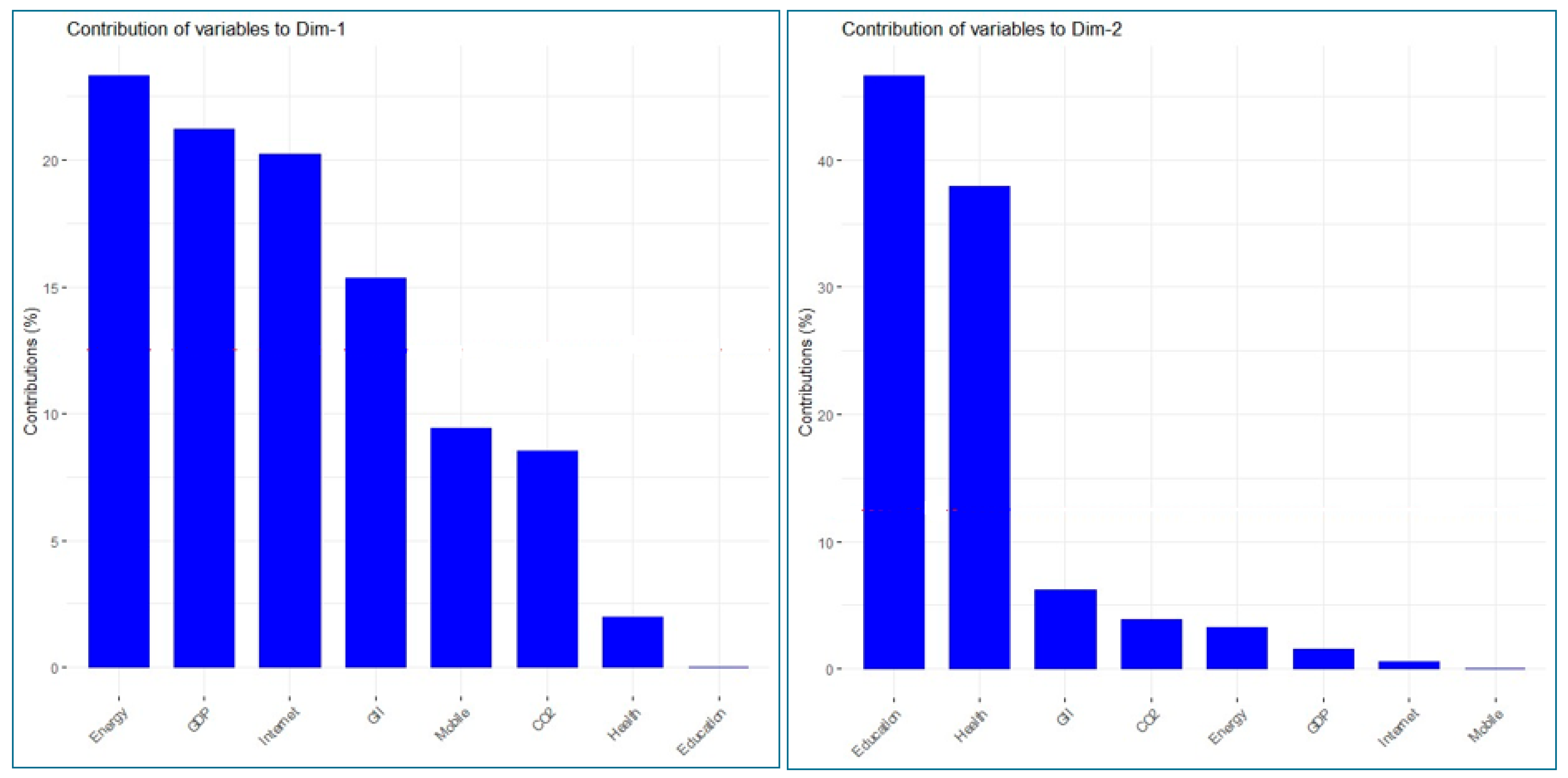

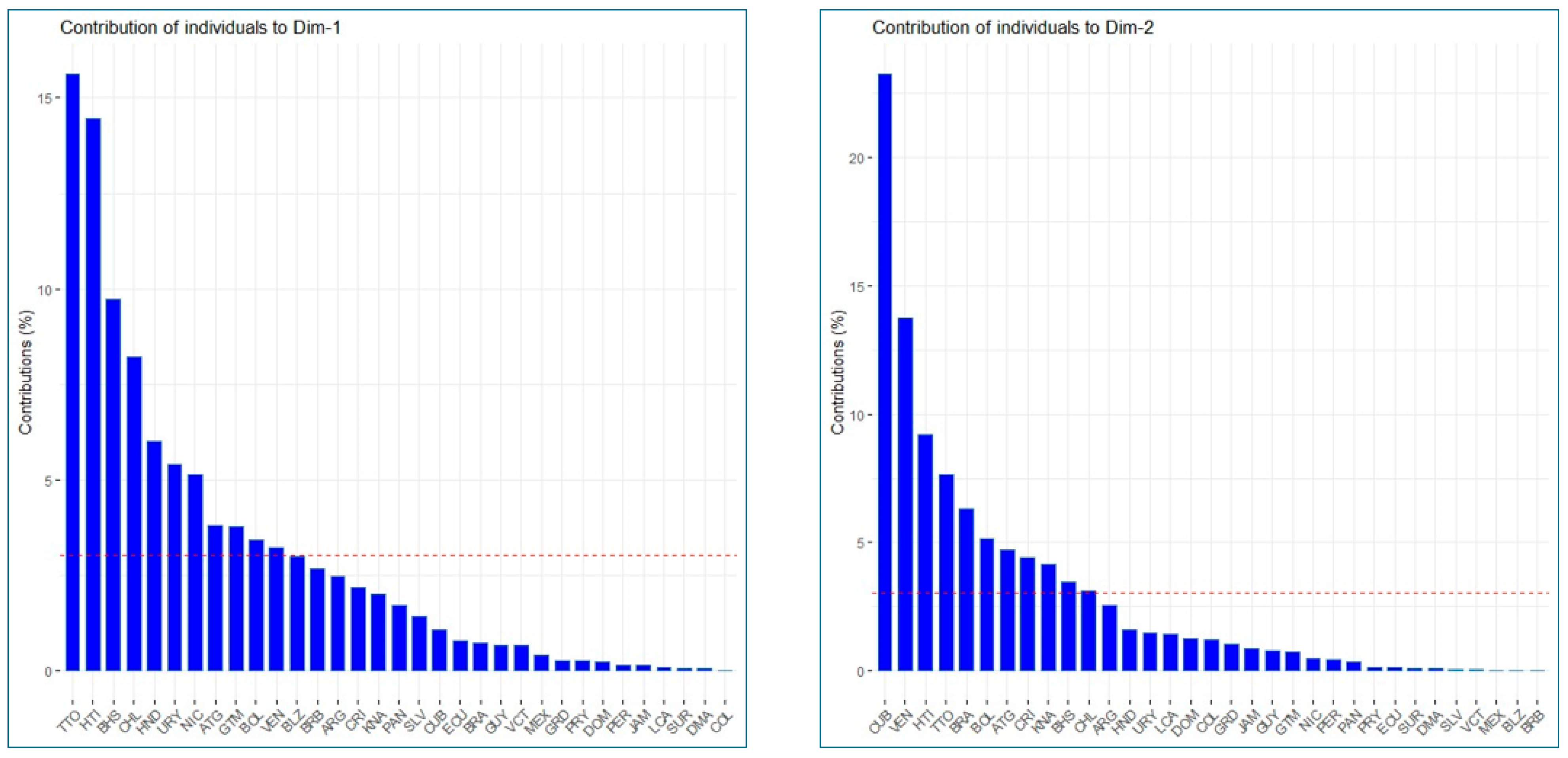
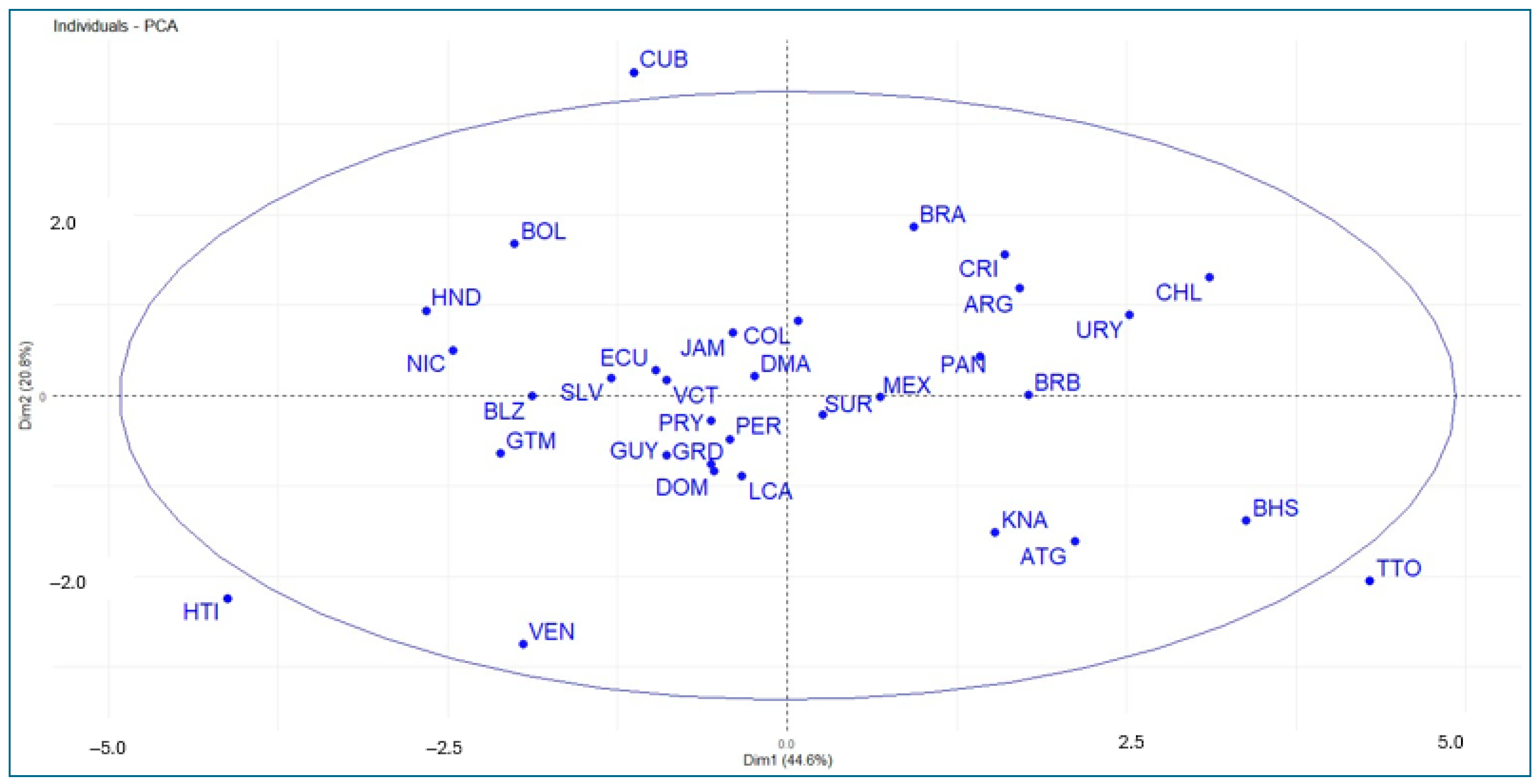
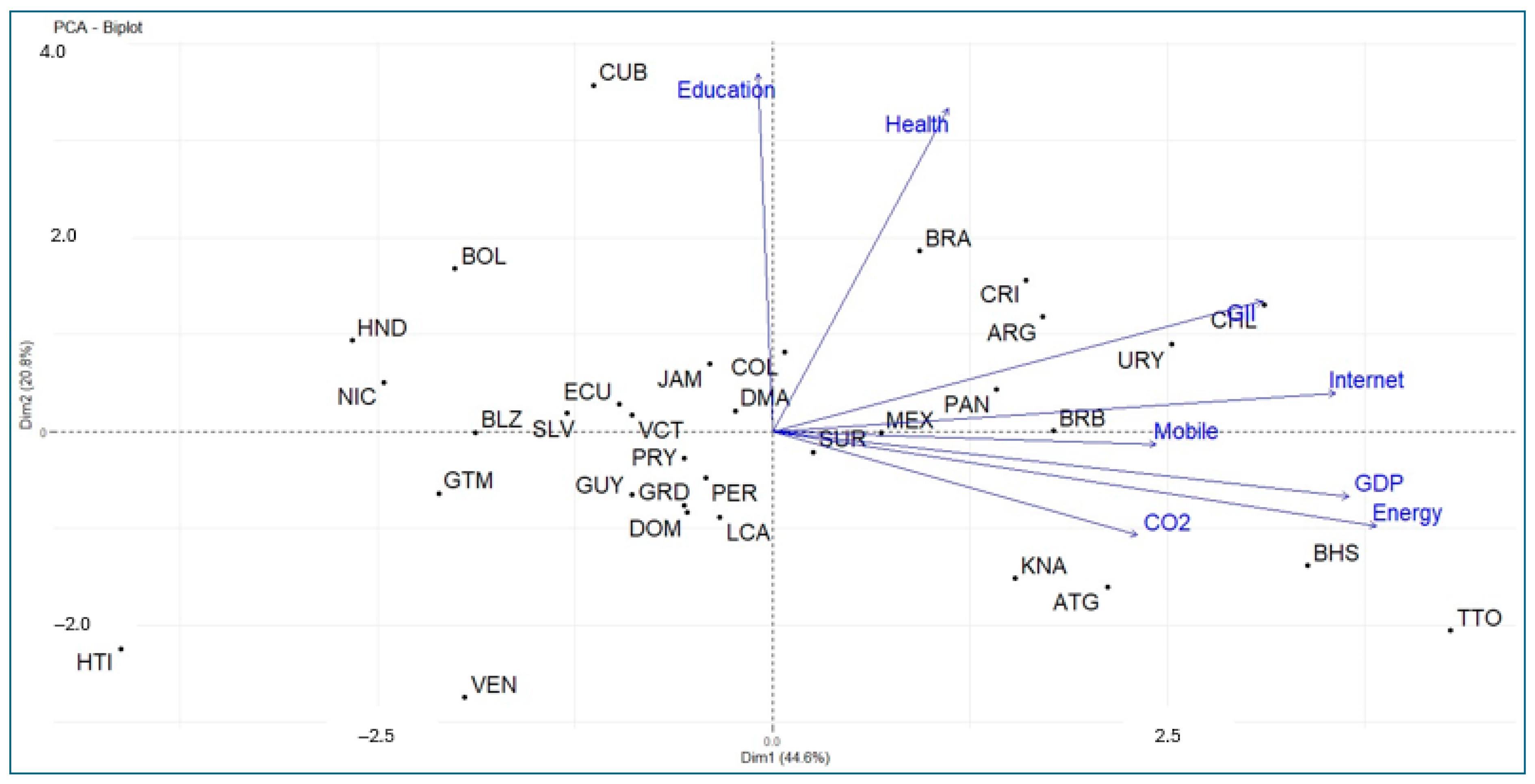
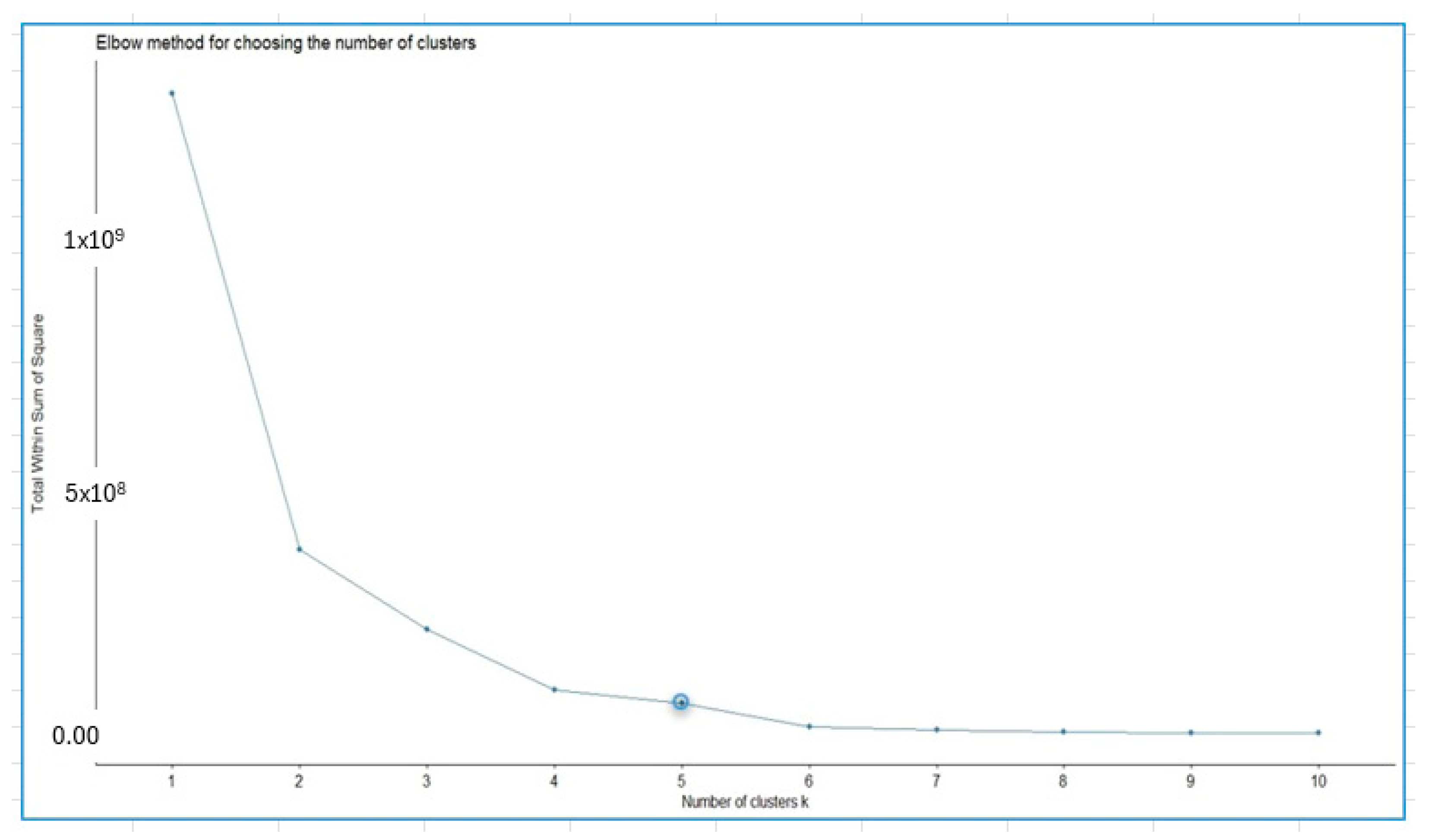

| Eigenvalues | Percentage of Variance | Cumulative Percentage of Variance | |
|---|---|---|---|
| Comp. 1 | 3.5657 | 44.5711 | 44.5711 |
| Comp. 2 | 1.6655 | 20.8192 | 65.3903 |
| Comp. 3 | 0.9364 | 11.7055 | 77.0958 |
| Variable | Contributions (%) | Quality of Representation | ||||
|---|---|---|---|---|---|---|
| Cosines-Squared | ||||||
| PC1 | PC2 | PC3 | PC1 | PC2 | PC3 | |
| Education | 0.014 | 46.609 | 5.269 | 0.0005 | 0.7763 | 0.0493 |
| Health | 1.972 | 37.971 | 1.574 | 0.0703 | 0.6324 | 0.0147 |
| GDP | 21.215 | 1.532 | 1.245 | 0.7565 | 0.0255 | 0.0117 |
| CO2 | 8.506 | 3.890 | 53.713 | 0.3033 | 0.0648 | 0.5030 |
| Energy | 23.309 | 3.237 | 6.822 | 0.8311 | 0.0539 | 0.0639 |
| Internet | 20.226 | 0.541 | 1.849 | 0.7212 | 0.0090 | 0.0173 |
| Mobile | 9.403 | 0.059 | 24.024 | 0.3353 | 0.0010 | 0.2250 |
| GII | 15.355 | 6.160 | 5.505 | 0.5475 | 0.1026 | 0.0515 |
| Cluster 1 | ||||||
| v-Test | Mean in Category | Overall Mean | SD in Category | Overall SD | p-Value | |
| Internet | −2.2088 | 48.2300 | 67.6088 | 13.3700 | 12.6060 | 0.0272 |
| Mobile | −2.2181 | 63.7350 | 111.7542 | 2.1350 | 31.1056 | 0.0265 |
| GII | −2.3001 | 23.1300 | 29.9655 | 0.5000 | 4.2701 | 0.0214 |
| Health | −2.4654 | 3.4650 | 6.8603 | 0.2850 | 1.9788 | 0.0137 |
| Education | −2.7658 | 1.4000 | 4.4788 | 0.0600 | 1.5994 | 0.0057 |
| Cluster 2 | ||||||
| v-Test | Mean in Category | Overall Mean | SD in Category | Overall SD | p-Value | |
| Health | 2.2389 | 8.5217 | 6.8603 | 1.7669 | 1.9788 | 0.0252 |
| GDP | −2.4863 | 3933.1667 | 9587.4242 | 1861.2954 | 6064.3399 | 0.0129 |
| Energy | −2.5896 | 887.2867 | 2183.7676 | 265.9774 | 1335.0502 | 0.0096 |
| GII | −2.6523 | 25.7183 | 29.9655 | 0.6158 | 4.2701 | 0.0080 |
| Internet | −3.3544 | 51.7517 | 67.6088 | 7.6461 | 12.6060 | 0.0008 |
| Cluster 3 | ||||||
| v-Test | Mean in Category | Overall Mean | SD in Category | Overall SD | p-Value | |
| Health | −2.3373 | 5.9079 | 6.8603 | 1.1620 | 1.9788 | 0.0194 |
| Cluster 4 | ||||||
| v-Test | Mean in Category | Overall Mean | SD in Category | Overall SD | p-Value | |
| GDP | 4.2543 | 16,504.2000 | 9587.4242 | 5246.0162 | 6064.3399 | 0.00002 |
| GII | 3.4299 | 33.8920 | 29.9655 | 3.4300 | 4.2701 | 0.00060 |
| Internet | 3.3839 | 79.0450 | 67.6088 | 6.7905 | 12.6060 | 0.00071 |
| Energy | 3.1763 | 3320.6240 | 2183.7676 | 890.9384 | 1335.0502 | 0.00149 |
| Mobile | 2.7969 | 135.0780 | 111.7542 | 27.5527 | 31.1056 | 0.00516 |
| Cluster 5 | ||||||
| v-Test | Mean in Category | Overall Mean | SD in Category | Overall SD | p-Value | |
| CO2 | 5.3575 | 22.2700 | 2.7500 | 0.0000 | 3.6435 | 0.00000 |
| Energy | 3.1479 | 6386.3200 | 2183.7680 | 0.0000 | 1335.0502 | 0.00164 |
| Cluster 1 | ||||
| Haiti | Venezuela | |||
| 1.2074 | 1.2074 | |||
| Cluster 2 | ||||
| Nicaragua | Honduras | Bolivia | Guatemala | El Salvador |
| 0.9127 | 0.9531 | 1.1994 | 1.9929 | 2.3526 |
| Cluster 3 | ||||
| Dominica | Guyana | Granada | Peru | Saint Vincent and the Grenadines |
| 0.5998 | 0.7962 | 0.8121 | 0.8655 | 0.8777 |
| Cluster 4 | ||||
| Barbados | Uruguay | Panama | Argentina | Chile |
| 0.7489 | 0.8515 | 1.1085 | 1.2764 | 1.8114 |
| Cluster 1 | ||||
| Haiti | Venezuela | |||
| 4.0230 | 3.1253 | |||
| Cluster 2 | ||||
| Cuba | El Salvador | Nicaragua | Honduras | Bolivia |
| 4.6306 | 3.1464 | 2.7973 | 2.7417 | 2.5856 |
| Cluster 3 | ||||
| Dominican Republic | Granada | Saint Lucia | Peru | Saint Vincent and the Grenadines |
| 3.1216 | 2.8962 | 2.7669 | 2.6545 | 2.5304 |
| Cluster 4 | ||||
| Bahamas | Chile | Antigua and Barbuda | Uruguay | Costa Rica |
| 4.7637 | 3.8848 | 3.7516 | 3.3213 | 2.9801 |
Disclaimer/Publisher’s Note: The statements, opinions and data contained in all publications are solely those of the individual author(s) and contributor(s) and not of MDPI and/or the editor(s). MDPI and/or the editor(s) disclaim responsibility for any injury to people or property resulting from any ideas, methods, instructions or products referred to in the content. |
© 2025 by the authors. Licensee MDPI, Basel, Switzerland. This article is an open access article distributed under the terms and conditions of the Creative Commons Attribution (CC BY) license (https://creativecommons.org/licenses/by/4.0/).
Share and Cite
Mendoza-Mendoza, A.; Visbal-Cadavid, D.; De La Hoz-Domínguez, E. Classification of Latin American and Caribbean Countries Based on Multidimensional Development Indicators: A Multivariate Empirical Analysis. Economies 2025, 13, 178. https://doi.org/10.3390/economies13060178
Mendoza-Mendoza A, Visbal-Cadavid D, De La Hoz-Domínguez E. Classification of Latin American and Caribbean Countries Based on Multidimensional Development Indicators: A Multivariate Empirical Analysis. Economies. 2025; 13(6):178. https://doi.org/10.3390/economies13060178
Chicago/Turabian StyleMendoza-Mendoza, Adel, Delimiro Visbal-Cadavid, and Enrique De La Hoz-Domínguez. 2025. "Classification of Latin American and Caribbean Countries Based on Multidimensional Development Indicators: A Multivariate Empirical Analysis" Economies 13, no. 6: 178. https://doi.org/10.3390/economies13060178
APA StyleMendoza-Mendoza, A., Visbal-Cadavid, D., & De La Hoz-Domínguez, E. (2025). Classification of Latin American and Caribbean Countries Based on Multidimensional Development Indicators: A Multivariate Empirical Analysis. Economies, 13(6), 178. https://doi.org/10.3390/economies13060178







